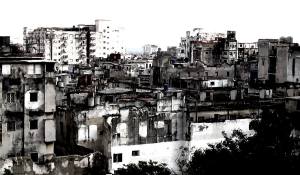The state institutions responsible for the hygiene and the beautification of the city give individualized attention to the touristic zones, such as the areas where the ruling elite lives. This is definitely a fact.
At the recent meeting of the Advice of Ministers, Raúl Castro said: “we have to develop […] we have the possibility to do it, in tourism, because every hotel that we finish is an open factory”. Therefore, since several years ago the Cuban government prioritizes investments in the tourism sector because it provides a great profit with its 3 million tourists in 2015, according to the Juventud Rebelde newspaper.

Cuba offers possibilities for tourism in almost all of its provinces and has more than 335 four and five star hotels. However, the majority of travelers choose the tourist destination of Havana because Castro’s propaganda presents itself as a new Havana, emerging from the ruins and restored against of “the inexorable passing of years”. Therefore, sights of touristic interest are being promoted, like the Tropicana cabaret with its lavish shows, the historical center in Old Havana, declared World Heritage by UNESCO, the Floridita restaurant with its famous Hemingway’s daiquiri, and La Bodeguita del Medio with its mojito and its pleasant odors of seafood and roast pork.
It is not surprising then that many young people aspire to work in the tourism sector as it is the best paid. It offers also a special status, superior to the majority of workers. It is an open secret that a place in the touristic area is trading between 200 and 500 CUC. A young mechanical engineer, now a crowded hotel parking attendant, remembers when he worked in a shipping company he was rewarded with a diploma and a cheap motorcycle for a great innovation. At that time, the salary did not cover basic monthly expenses, but since he got his new job he lives better, and more importantly: he is within the industry and has possibilities to improve his economical situation even more.
Ignacio is an average kitchen technician, graduated in the Instituto Tecnológico José Martí. Before, when he used to work as a cook in a planning center of the Ministry of Education many times he had to bring his own condiments and to pinch the leftovers to sell to pig farmers. Since working in a tourist-oriented restaurant, he has a better salary, the supplies and ingredients necessary for cooking good food don’t miss and, always, he catch something to take home, which is not a minor detail in nowadays Cuba.
But we are talking about the other Havana, the virtual one that is offered to tourists. The true Havana is a city in darkness, of disrupted streets and sidewalks, flooded with sewage whose scent is confused with that of uncollected garbage dumps for several days. A Havana that does not receive necessary attention, with an aging population which roams the streets with shabby clothes, with meager pensions and appalled by rising food prices.
The capital of all Cubans, with close to half a million illegal inhabitants coming from other provinces, filled with neighborhoods in the style of shantytowns, unsanitary slums built with mostly waste materials, without running water or sewage. The real Havana, the ruined, the destroyed one, is inhabited by a tired people who little by little, very slowly, are losing fear.

Leave a comment